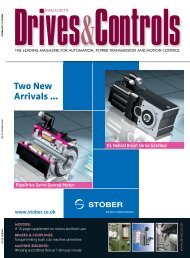New Danfoss VLT® Decentral Drive E cient, reliable and powerful
New Danfoss VLT® Decentral Drive E cient, reliable and powerful
New Danfoss VLT® Decentral Drive E cient, reliable and powerful
Create successful ePaper yourself
Turn your PDF publications into a flip-book with our unique Google optimized e-Paper software.
BEARINGS, BELTS & CHIAINS<br />
identification of potential<br />
problems.<br />
> Remedial action<br />
The most effective<br />
preventative or remedial<br />
action in the event of<br />
electrical erosion in bearings<br />
will depend on the<br />
characteristics of the<br />
equipment <strong>and</strong> on the<br />
interventions available to the<br />
engineer. In new installations,<br />
risks can be minimised by<br />
using symmetrical multi-core<br />
motor cables in which the<br />
earth conductor is either<br />
arranged as a concentric<br />
shield around the phase leads<br />
or as three separate leads<br />
positioned between them.<br />
Shielded motor cables can<br />
also provide a short, lowimpedance<br />
path for commonmode<br />
current to return to the<br />
inverter. Likewise, a<br />
grounding brush on the<br />
motor shaft can offer an<br />
easier path to earth than that<br />
provided by the motor<br />
bearings. Effective grounding<br />
between other motor<br />
components can also be<br />
important.<br />
The high-frequency<br />
switching that can be a major<br />
cause of electrical erosion can<br />
sometimes be minimised by<br />
changing the characteristics<br />
of the drive control program,<br />
or by installing dedicated<br />
filters in the drive circuit.<br />
The use of bearings with<br />
insulating housings can<br />
eliminate the electrical<br />
pathway through the motor<br />
bearings, thus preventing<br />
erosion. Insulated bearings are<br />
readily available, but different<br />
coatings <strong>and</strong> bearing designs<br />
have different characteristics<br />
when exposed to highfrequency<br />
AC currents.<br />
Bearing manufacturers have<br />
tested their proprietary<br />
designs under a wide range of<br />
operating conditions <strong>and</strong> can<br />
offer advice on the most<br />
suitable bearings for particular<br />
applications. In some cases,<br />
bearings with ceramic rolling<br />
elements can be particularly<br />
useful, providing perfect<br />
electrical insulation between a<br />
motor’s stator <strong>and</strong> rotor. D&C<br />
Solar plant uses plain<br />
bearings to track the sun<br />
More than 1,000 precision plain bearing<br />
rod ends are playing a key role in the<br />
world’s largest parabolic trough solar<br />
power station – the 50MW Andasol 1 plant in<br />
southern Spain<br />
The €300m plant, which went on line in mid-<br />
2009, is expected to generate about 180GWh a<br />
year – supporting the power needs of more than<br />
200,000 people, <strong>and</strong> saving around 150,000<br />
tonnes of carbon dioxide. It is the first of three<br />
similar plants being built at the site in Andalusia.<br />
The plant consists of three main parts, the<br />
largest being an array of solar troughs with a<br />
collector area of more than 510,000m 2 –<br />
equivalent to around 70 soccer pitches. There is<br />
also a power plant area <strong>and</strong> a heat accumulator,<br />
which allows the station to continue generating<br />
electricity even in cloudy weather or after sunset.<br />
The solar field consists of parallel rows of<br />
parabolic collectors arranged on a north-south<br />
axis to follow the path of the sun from east to<br />
west. To track the sun, each collector is fitted<br />
with a hydraulic drive.<br />
The trough-shaped parabolic mirrors focus<br />
the solar radiation onto an absorber pipe,<br />
positioned along the collector’s focal line. A<br />
closed-circuit pipe system uses synthetic oil to<br />
transfer heat at up to 400°C. The heated oil is<br />
pumped to a power block where it flows<br />
through a heat exchanger. The next stage is<br />
similar to the steam cycle in a conventional<br />
power plant – the steam generated in the heat<br />
exchanger drives a turbine connected to a<br />
generator. The steam then condenses back into<br />
water, which is recirculated.<br />
A total of 1,248 Elges hydraulic rod end<br />
bearings supplied by Schaeffler support the<br />
solar troughs, positioning them with millimetre<br />
precision to follow the sun.<br />
“High-precision bearings are required so that<br />
the power plant can operate at maximum<br />
efficiency,” explains Dr Arndt Schweigert, head<br />
of Schaeffler’s power generation sector.<br />
“Moreover, the bearings also have to withst<strong>and</strong><br />
loads that should not be underestimated.”<br />
The plain bearings have been optimised for<br />
the slow, precise swivel motion. It is critical that<br />
these movements are smooth, without any<br />
stick-slip effects or jolting on start-up.<br />
At the same time, the hydraulic rod ends<br />
need to support high forces <strong>and</strong> to h<strong>and</strong>le<br />
alternating loads. This allows the 150m-long<br />
chains of collectors to be adjusted to within a<br />
tenth of a millimetre.<br />
The rod ends are fitted with manganese<br />
phosphate-coated radial spherical plain bearings<br />
with steel-to-steel sliding contact surfaces. The<br />
Parabolic reflectors focus the<br />
sun’s energy on a pipe carrying oil<br />
which is heated to 400°C<br />
surface treatment improves the running-in<br />
characteristics <strong>and</strong> reduces friction. The inner<br />
ring of the spherical plain bearing is 70mm wide<br />
<strong>and</strong> has a 110mm cylindrical bore diameter, as<br />
well as a spherical outer slideway. The 160mmdiameter<br />
outer ring has a cylindrical outer<br />
surface <strong>and</strong> a concave inner slideway with a<br />
diameter of 140mm.<br />
Schaeffler has also provided 7,488 lead-free<br />
plain bearing strips for the Andasol plant. These<br />
are mounted in the supports between the<br />
individual segments of the 150m-long collector<br />
chains, ensuring smooth slewing movements<br />
while tracking the sun.<br />
30 November/December 2010 www.drives.co.uk




